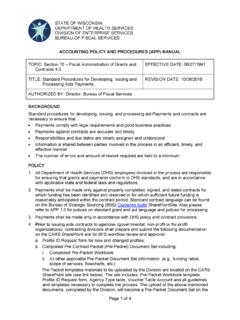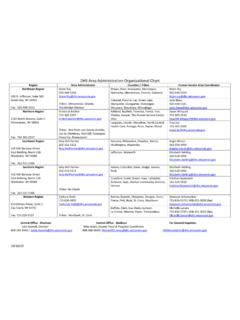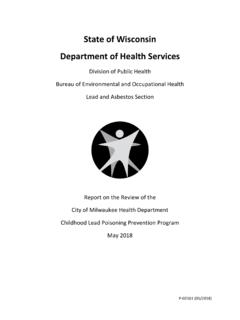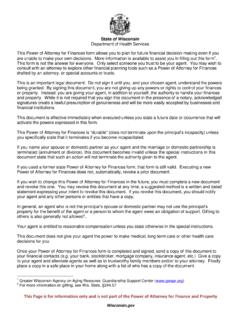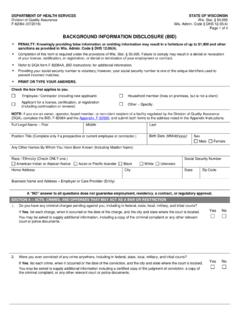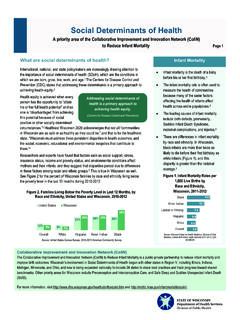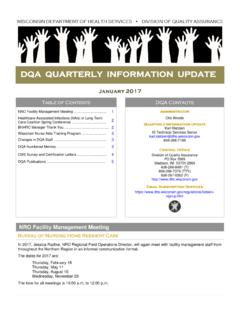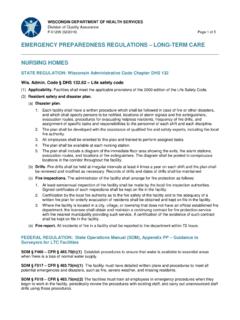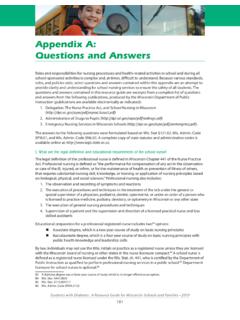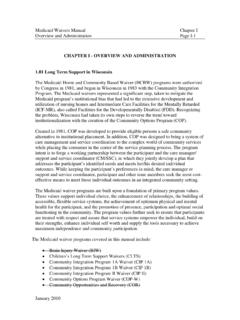Transcription of ACCOUNTING POLICY AND PROCEDURES (APP) MANUAL
1 STATE OF WISCONSIN DEPARTMENT OF HEALTH SERVICES DIVISION OF ENTERPRISE SERVICES BUREAU OF FISCAL SERVICES Page 1 of 6 ACCOUNTING POLICY AND PROCEDURES (APP) MANUAL TOPIC: Section 3 Revenues and Refunds EFFECTIVE DATE: 09/27/1985 TITLE: ACCOUNTING for Revenues and Refunds of Expenditure REVISION DATE: 02/10/2018 AUTHORIZED BY: Deputy Director, Bureau of Fiscal Services INTRODUCTION This POLICY establishes criteria for proper classification of revenues and refunds of expenditure. A clear distinction needs to be made between revenues and refunds of expenditures in order to comply with generally accepted ACCOUNTING principles, the appropriation structure, and statutory restrictions on refunds of expenditure. When a receipt or refund is received, two questions should be asked: 1. Is the transaction a revenue or a refund of expenditure? 2. What is the proper ACCOUNTING treatment, given the appropriation type and ACCOUNTING period?
2 This POLICY provides guidance in classifying revenues and refunds of expenditures, and specific PROCEDURES are established to insure that receipts are handled uniformly throughout the Department of Health Services (DHS) and that the PROCEDURES are in conformance with statutory intent, budgetary practices and the Department of Administration (DOA) standards. BACKGROUND A. Is the transaction a revenue or a refund of expenditure? 1. Revenues Revenues are generated as the result of delivering or producing goods, rendering services or other activities related to an organization's ongoing major or central operations. Revenues are recognized as the result of an earnings process that is completed and an exchange that has taken place. In addition, miscellaneous revenues may be generated by occasional sales, by the sale of surplus equipment, or by unanticipated income. 2. Refunds of Expenditure In contrast, refunds of expenditure are adjustments of amounts previously paid.
3 The most common type of refund of expenditure involves overpayments to vendors, in the same fiscal year, where a check may be redeposited or the vendor returns all or a portion of an incorrect payment. Refunds of expenditures are defined by Wis. Stat. (5) as amounts received by a state agency: a. as the result of an adjustment due to activities that are of a temporary nature or activities that could not be anticipated during budget development and b. that reduce or eliminate a previously recorded expenditure in the same fiscal year in which the previously recorded expenditure was made. Section 3 Revenues and Refunds P-00748 Page 2 of 6 B. What is the proper ACCOUNTING treatment, given the appropriation type and ACCOUNTING period? 1. Appropriation Type The appropriation type is one of the factors in determining the proper ACCOUNTING treatment for a receipt especially for revenues. See Attachment 1 Coding for Revenues and Refunds of Expenditures.
4 A. GPR Appropriations Receipts that should be booked to a revenue account for General Purpose Revenue (GPR) Appropriations should be booked to GPR-Earned. Wis. Stat. (4) defines GPR-Earned as revenue which is received by a state agency incidentally in connection with GPR appropriations in the course of accomplishing program objectives and for which no program revenue (PR) appropriation is made. GPR-Earned is treated as a non-appropriated receipt and is not available for expenditure. b. Federal Appropriations Receipts that should appropriately be booked to a revenue account for PRF Appropriations should be booked as a credit to expenditure, because that is how we return funds to the federal government. c. PR & SEG Appropriations Receipts that are applicable to PR & SEG appropriations need to be handled on a case-by-case basis. 2. ACCOUNTING Period (state fiscal year, grant period etc.) The ACCOUNTING period is one of the factors in determining the proper ACCOUNTING treatment for a receipt especially for refunds of expenditure.
5 See Attachment 1 Coding for Revenues and Refunds of Expenditures. Generally, refunds of expenditure in the same fiscal year are coded as credits against expenditures in the same appropriation as previously recorded. Wis. Stat. (5) indicates that any refunds of expenditures to sum certain appropriations in the same fiscal year as the expenditure was made should be coded as a refund of expenditure in the same appropriation as the original expenditure. However, certain prior-year refunds of expenditure (namely, GPR sum certain, GPR biennial, PR annual and SEG annual) are treated as revenues due to the appropriation type and statutory provisions. Prior fiscal year refunds of expenditure for GPR sum certain and GPR biennial appropriations are coded as GPR-Earned (non-appropriated receipts) and are not available for expenditure. Prior fiscal year refunds of expenditure for PR annual and SEG annual appropriations are coded to miscellaneous revenue.
6 POLICY 1. All centralized and decentralized ACCOUNTING units are to implement State and Department policies and PROCEDURES regarding proper ACCOUNTING treatment of revenues and refunds of expenditure. All transactions for invoice vouchers, journal vouchers, and deposit vouchers must be consistent with this POLICY and properly authorized and signed. DHS staff involved in classifying receipts is responsible to identify transactions that may be inconsistent with this POLICY and notify a financial manager, Bureau of Fiscal Services (BFS), prior to recording the transaction. BFS staff is to apply these policies in preparing, processing and/or reviewing transactions. 2. Proper ACCOUNTING treatment of revenues and refunds of expenditure require that: a. Revenues Revenues are recognized based upon the earning process and/or the appropriation structure. Most revenues, including miscellaneous or incidental revenue, should be deposited to the respective appropriation and revenue source regardless of Section 3 Revenues and Refunds P-00748 Page 3 of 6 fiscal year received.
7 GPR-Sum Sufficient and PRF appropriations should be recorded as credits to expenditure. Occasional sales and incidental receipts are coded as miscellaneous revenue or GPR-Earned. GPR-Earned is treated as a non-appropriated receipt and is not available for expenditure. See Attachment 1 Coding for Revenues and Refunds of Expenditures. b. Refunds of Expenditure Generally, refunds of expenditure reduce or eliminate previously recorded expenditures in the same fiscal year in which the previously recorded expenditure was made. Refunds of expenditure must be coded based on the appropriation in which the previously recorded expenditure was recorded. All refunds of expenditure must meet criteria detailed in #3 below. Certain prior year refunds of expenditure must be coded as revenues due to the appropriation structure and statutory provisions (GPR sum certain and GPR biennial, PR annual and SEG annual). Follow guidance outlined in the Attachment 1 Coding for Revenues and Refunds of Expenditure.
8 3. Only the following types of refunds of expenditure are permitted: a. Vendor Overpayments. Receipts from vendors, including other units within DHS or other state agencies, within the same fiscal year due to overpayment or incorrect payment are classified as a refund of expenditure. Incorrect payment may be the result of an error in processing, incorrect vendor invoice, or a misaddressed check. Overpayment may include discounts not previously taken, credits not previously applied or settlement of disputes over the quality or quantity of goods or services provided. b. Outside Reimbursement of Certain Travel Expense. Employee travel or training expenses required by and reimbursed by an external organization, such as a federal agency, professional or philanthropic organization, and which can t be recorded in a program revenue appropriation should be classified as a refund of expenditure. In this situation, DHS staff is reimbursed for travel and training costs by an outside organization that does not issue a grant award to the Department but rather provides a letter authorizing the employee to travel or attend training.
9 Generally a dollar limit is provided. Under APP Section 12 Travel (Reimbursement of Costs to Employees Outside of State Agencies), all remuneration received by employees as part of their official duties is to be deposited with the Department of Administration, and all employee travel reimbursement is to be at the standard rates specified in the Uniform Travel Schedule Amounts (UTSA). DHS claims reimbursement from the outside organization in the amount reimbursed to the employee. The payment from the outside organization is recorded as a refund of expenditure up to the amount previously paid. Any amount paid over the amount claimed (such as may occur with per diem reimbursement) is to be recorded as GPR-Earned or miscellaneous revenue in a program appropriation. c. Medical Assistance Collections. Medical assistance collections include third party liability collections, probate collections, collections due to recoveries from fraud and abuse, collections on liens, provider repayments, drug rebates, and recoveries from quality control activities.
10 Estimated collections are subtracted from estimated gross program expenditures to calculate the amount of GPR and PRF needed for expenditure. Since Medical Assistance is funded by both state and federal funds, federal requirements for reporting federal share as a reduction of expenditure has been applied to Medical Assistance Collections. Section 3 Revenues and Refunds P-00748 Page 4 of 6 d. Receipts Subject to Federal Regulations. WIC Formula and other rebates as required by federal regulations, guidelines or instructions may be treated as a refund of expenditure. Federal reporting requirements dictate that rebates received be reported as a reduction from total federal expenditures reported. Rebates are applied to the same federal fiscal year as the original expenditure. Recording of the rebate as a refund of expenditure in the ACCOUNTING system is consistent with how we report to the federal grantor agency.
